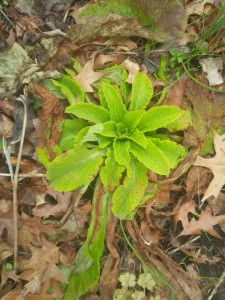For those of us in cold winter climates, mid-fall is the time to say a gradual goodbye to flowers. Annuals will soldier on until the first hard frost, but they are slowing down in anticipation of the inevitable. Most perennials have finished up, with the exception of a few Montauk daisies, tall sedums, fall crocuses and the very last of the big asters. The roses, their colors glowing in the October light, will keep on going until they are also stopped by frost. And because nature is made up of an endless array of intersecting ecosystems, the butterflies that frequent the fading flowers are likewise mostly gone.
I say my goodbyes to the flowers as I do the fall clean-up. I haven’t yet resorted to a leaf blower, because my property doesn’t have many trees. Besides, raking gives me the time and relative quiet to think. Cutting back perennial and annual stalks and tidying up the beds is good for the same reasons. Even pruning the exuberant roses-of-Sharon is a thoughtful exercise—except when I have to use the pruning saw on thick branches. As I take up the pruning saw, I think more about not cutting myself and less about great insights.
On the surface, fall is about staring the seasonal Grim Reaper directly in the face. Look a little deeper, though, and all kinds of revelations and new beginnings pop up. I am completely besotted with the little wild blue asters that grow abundantly all over the place at the very end of the growing season. These branched plants, with flowers about half an inch wide, are cheeky specimens with no sense of decorum whatsoever. They wait until most of the other flowers are gone and then erupt brazenly through formal box hedges or spring up unbidden in perennial beds. I have seen the pale blue flowers hovering over giant hosta leaves, having fought bravely through unbroken waves of undulating pleated foliage. I see them peeking out at the bases of trees in my local county park and emerging from crevices in dry-laid stone walls. I am sure they were “planted” by windblown seeds and thrive in defiance of the increasingly chilly nights.
Some of those asters lurk in the less tended parts of my garden. I take pains not to pull them out because they are so beautiful.
As I rake debris out of the flower beds, I can see the rounded leaves of young columbines or aquilegia. Columbine is a masterful self-sower, and has ingratiated itself in almost every part of the garden. Most of my columbine are blue, which must be a dominant color, but a few are white or pink. Right now the low-growing columbines look so fresh and green that I expect them to sprout flower stalks immediately. They will wait until spring, but the leaves are a hopeful sign.
The same is true of the self-sown foxglove or digitalis. It too has a propensity for scattering seed at random and its lettuce-like young leaves are popping up almost as often as columbine. A large one is currently rooted in a narrow crack at the back of the driveway. Foxglove has been well-loved as a medicinal and ornamental plant for centuries. Its toughness has made it a reliable component of Nature’s pharmacopeia. Of course, it is also poisonous, if ingested by the unwary.
I leave the last of the roses to develop the hips that are so loved by birds. The hips that appear now are sour, but will sweeten as temperatures grow colder. This is why the blue jays ignore them in October in favor of a tastier diet. By December they may not be so picky.
When I look out my bedroom window, I can see the naked red-orange branches of the red willow—Salix alba var. vitellina ‘Britzensis’. A late summer pruning of this shrub, which I grow as a small tree, spurred the new growth. The same October light that flatters the roses, flames the willow. The branches seem to contain the warmth that is now missing from the air.
Just as the annual leaf drop from the maple tree in front of the house reaches its peak, the boxes of spring bulbs arrive. Though small, the bulbs are the greatest weapon in the annual battle against the dying of the light. I plant them in groups of three or five and think about spring. A few of the hyacinths always end up refrigerated for forcing around the first of the year. When faith flags at the end of winter, nothing is better than the smell of hyacinths in the house.
Real gardeners are in the optimism business in all four seasons.

